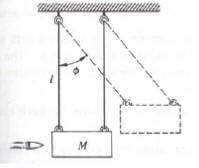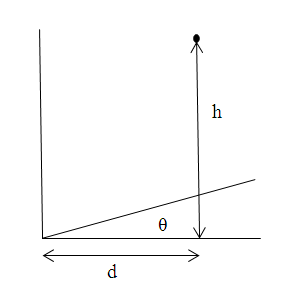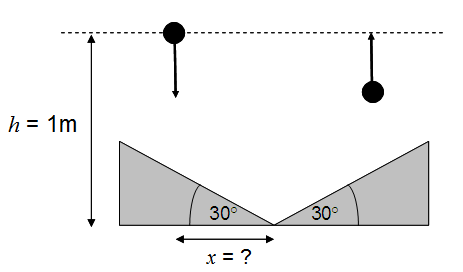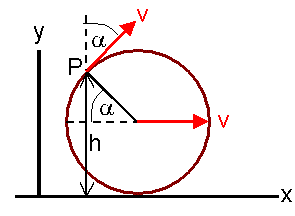Conservation laws
Problem:
A simple
way to measure the speed of a bullet is with a ballistic pendulum. As
illustrated, this consists of a wooden block of mass M into which the
bullet is shot horizontally. The block is suspended from cables of
length l, and the impact of the bullet causes it to swing through a
maximum angle Φ, as shown. The initial speed of the bullet is v and its
mass is m.
(a) What is the speed of the block V immediately after the bullet comes
to rest inside the wooden block? (Assume that this happens quickly.)
(b) Find an expression for the speed v of the bullet in terms of the
quantities that can be easily measured m, M, g, l, and Φ.

Solution:
- Concepts:
Conservation laws
- Reasoning:
Use conservation of momentum for the first part of the problem and
conservation of mechanical energy for the second part.
- Details of the calculation:
(a) pinitial = mv, pfinal = (m + M)V,
V = vm/(m + M).
(b) Set the zero of the potential energy at zero displacement of the
block.
Just after the bullet comes to rest: E = T + U = ½(m + M)V2
= ½[m2/(m + M)]v2.
When the block reaches the maximum angle Φ: E = (m + M)gh = (m + M)gl(
1 - cosΦ).
Energy conservation: ½[m2/(m + M)]v2 = (m + M)gl(
1 - cosΦ), v2 = 2(m + M)2gl( 1 - cosΦ)/m2.
v = [(m + M)/m](2gl(1 - cosΦ))½.
Problem:
An plane, inclined at θ = 20o, touches a wall as shown in the
picture. You drop a small, perfectly elastic ball from a height h = 1.5 m
onto the onto the plane. The ball falls from rest. You do not move
your hand. At what distance d from the wall do you have to drop it so that
it bounces back into your hand?

Solution:
- Concepts:
Energy
conservation, kinematics
- Reasoning:
The ball has to retrace its
trajectory. It has to hit the wall at 90o.
- Details of the calculation:
When the
ball bounces off the plane it makes an angle of 20o with the
normal to the plane or θ' = 50o with respect to the horizontal.
Assume it has speed v. Its velocity components are vx = -vcosθ',
vy = vsinθ'. It executes projectile motion and reaches its
maximum height at tmax_height = vsinθ'/g. During this
time it travels a distance d = vcosθ'*vsinθ'/g = v2sin(2θ')/(2g).
If the distance to the wall is d, it hits the wall at 90o and
bounces off horizontally. It then retraces its trajectory. We
need v2 = 2gd/sin(2θ').
But
½mv2 = mg(h - d tanθ), (h - d tanθ) = d/sin(2θ'),
d*(1/sin(2θ') + tanθ) = h.
d = h/(1/sin(2θ') + tanθ) = 1.09 m.
Problem:
Two wedges are placed mirror symmetrically so that the tip of one touches the
tip of another as shown in the figure below. The surface of each wedge is at
angle θ = 30 degrees relative to the ground. A small elastic ball is dropped
from height h = 1 m with zero initial velocity. How far from the tips of the
two wedges (x) must the small ball be dropped, so that after bouncing from the
two wedges it will reach the same height from where it was dropped?
Neglect any friction from air and consider the bouncing of the ball to be
completely elastic.

Solution:
- Concepts:
Energy conservation, kinematics
- Reasoning:
The ball's trajectory must be symmetric about the midpoint
between the wedges. It has to cross the midpoint with its velocity having
no vertical component.
- Details of the calculation:
Just after the ball bounces off the plane
its velocity makes an angle of 30o with the normal to the plane
and therefore also an angle of θ' = θ = 30o with respect to the
horizontal. Assume it has speed v. Its velocity components are vx
= vcosθ, vy = vsinθ. It executes projectile motion and reaches
its maximum height at tmax_height = vsinθ/g. During this time
it travels a distance
d = vcosθ*vsinθ/g = v2sin(2θ)/(2g). If
the distance to the middle is d, it crosses the midpoint with its velocity
having only a horizontal component. The second half of its trajectory then
mirrors the first half. We need v2 = 2gd/sin(2θ).
But ½mv2
= mg(h - d tanθ), (h - d tanθ) = d/sin(2θ), d (1/sin(2θ) + tanθ) = h.
d
= h sin(2θ)/(1 + 2sin2θ) = 0.577 m.
Problem:
A wheel of radius b is rolling along a muddy road with a speed v. Particles
of mud attached to the wheel are being continuously thrown off from all points
of the wheel. If v2 > 2bg, where g is the acceleration of gravity,
find the maximum height above the road attained by the mud, H = H(b,v,g).
Solution:
- Concepts:
Energy conservation, projectile motion,
- Reasoning:
The mud particles are projectiles acted on by the gravitational force.
Mud particles thrown from different positions on the rim follow different
trajectories and rise to different heights. We will label the position on
the rim by some parameter α, calculate the height reached by a particle
leaving from this position, and then find the maximum height as a function
of the parameter α.
- Details of the calculation:

Assume mud is ejected from a point P, and define α and h as in the figure.
Let Δh be the height the mud rises above the ejection point. Conservation
of energy yields
mgΔh = (mvy2)/2 = (mv2 cos2α)/2,
Δh = (v2 cos2α)/2g.
The height H reached by the mud is H = h + Δh = b + b sinα + (v2
cos2α)/2g.
We find the maximum height by setting dH/dα = 0.
This yields b cosα - (v2/g) cosα sinα = 0. Two solutions to this
equation exist.
(i) cosα = 0, α = π/2, H = 2b.
This is the maximum height only if b sinα + (v2 cos2α)/2g
≤ b
for all angles α,
or v2 ≤ 2gb.
Then we do not have v2 > 2gb.
(ii) sinα = gb/v2 = sinα0. Then
H = b + b sinα0 + v2(1 - sin2α0)/(2g)
H = b + gb2/v2 + (v2/2g)(1 - g2b2/v4)
Problem:
In one dimension, a particle is acted upon by an attractive force F = −kx3.
(a) Show that the period for the motion of this particle is inversely
proportional to the amplitude.
(b) By contrast show that the period
for the motion of a particle subjected to the force F = −kx is independent of
the amplitude.
Solution:
- Concepts:
Energy conservation, periodic motion
- Reasoning:
The given forces are conservative forces derivable from a
potential. U(x) is a potential well.
- Details of the calculation:
(a) The force is a conservative force derivable from a potential.
U(x) = ¼ kx4.
This is a potential well and the particle's motion will be periodic.
Energy conservation: ½m(dx/dt)2 + ¼kx4
= E = constant
Solving for the velocity we obtain
dx/dt = (2E/m - kx4/(2m))½.
Setting dx/dt = 0 we obtain the amplitude of the motion, A = (4E/k)¼.
The period is obtained from
τ = ∫0τ dt = 4∫0A dx (2E/m
- kx4/(2m))-½ = 4(2m)½∫0A
dx (kA4 - kx4)-½
= (4/A)(2m/k)½∫01 dy (1 - y4)-½,
with x = Ay.
The period is inversely proportional to the amplitude.
(b) U = ½kx2,
we have simple harmonic motion.
The amplitude for SHM is given by A =
(4E/k)½. The period is obtained from
τ = ∫0τ dt = 4∫0A dx (2E/m
- kx2/(2m))-½ = 4(2m)½∫0A
dx (kA2 - kx4)-½
= 4(2m/k)½∫01 dy (1 - y4)-½,
with x = Ay.
The period is independent of the amplitude.
Problem:
A particle of mass m is subjected to a force whose potential energy is U(x) =
ax2 - bx3,
with a and b constants and a > 0.
(a) Find the force.
(b) Assume that the particle starts at the origin with velocity of magnitude v0.
Show that if
v0 < vC, where vC is a certain critical
velocity, the particle will be confined in a region near the origin. Find vC.
Solution:
- Concepts:
Motion in 1D subject to a conservative force
- Reasoning:
The potential energy function has a local maximum and a local minimum.
Depending on the total energy of the particle, it can either be trapped in
the region of the local minimum, or be free.
- Details of the calculation:
(a) F(x) = - dU/dx = -2ax + 3bx2. F = 0 at x = 0 and at x =
(2/3)(a/b).
d2U/dx2 = 2a - 6bx.
At x = 0 d2U/dx2 = 2a and at x = (2/3)(a/b) d2U/dx2
= -2a.
If a > 0 then U(x) has a local minimum at x1 = 0 and a local maximum
at x2 = (2/3)(a/b).
There are only two local extrema. U(x) has an absolute maximum x = -sign(b)*∞
and an absolute minimum x = sign(b)*∞.

If the particle moves through x = x1 = 0 with speed v0
in the direction of -sign(b), its speed will decrease until all its kinetic
energy has been converted to potential energy, and then increase again, with the
velocity having changed sign. It will move through the origin with speed v0
in the direction of sign(b).
If the particle moves through x = 0 with speed v0 in the direction
of sign(b), its speed will decrease until all its kinetic energy has been
converted to potential energy and then increase again with the particle moving
in the opposite direction, unless the particle reached x = x2 =
(2/3)(a/b) with speed v > 0. It can then move across the potential barrier and
it will move with increasing speed in the direction of sign(b).
The critical speed vC is found from ½mvC2 = ax22
- bx23 = (4/27)a3/b2.
vC = (2/(3b))(2a3/m)½.
Problem:
A ball is dropped down an elevator shaft. The elevator has an upward
speed V. The instant the ball is dropped, the top of the elevator is below
it by a distance h. How high will the ball rebound above the point from
which it was dropped?
Solution:
- Concepts:
Conservation of mechanical energy, frame transformations
- Reasoning:
Compared to the ball the elevator is "infinitely" massive. The frame of the
elevator is an inertial frame. In the frame of the elevator, a dropped ball
makes an elastic collision with the floor and bounces back. Its speed just
before the collision equals its speed just after the collision.
- Details of the calculation:
In the frame of the elevator, the ball has an initial speed V. It will
contact the floor after a time interval Δt.
We have VΔt + ½gΔt2
= h, Δt > 0. The speed of the
ball after the time interval Δt is V
+ gΔt. In the frame of the elevator
the speed of the ball just after the bounce is v = V + gΔt,
and the ball is moving upward.
In the frame of the ground, the speed of the ball just after the bounce is v =
2V + gΔt and the ball is moving
upward. Its kinetic energy is ½mv2. It will rise a distance
Δh = ½v2/g above the
contact point, which is at h - VΔt
below the point from which the ball was dropped, since in the time interval Δt the elevator as risen a distance VΔt.
In the frame of the ground the ball will therefore rise a distance h' = Δh - h + VΔt above the point
from which it was dropped.
Δt = ((V2+2gh)½
- V)/g
v = V + (V2+2gh)½
Δh = (V2+gh+V(V2+2gh)½)/g
VΔt = (V(V2+2gh)½
- V2)/g
h' = (V2+gh+V(V2+2gh)½)/g + (V(V2+2gh)½-V2)/g
- h = 2V(V2+2gh)½)/g
In the frame of the ground, the ball rebounds to a height h' = 2V(V2+2gh)½)/g
above the point from which it was dropped.





